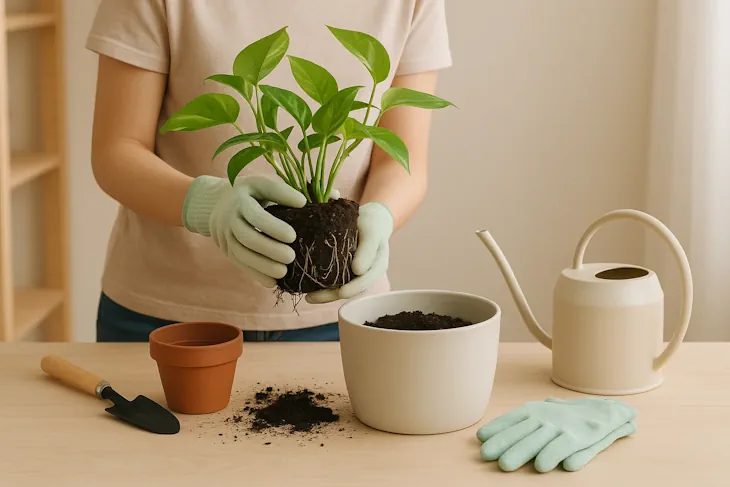Pothos, also known as Devil’s Ivy, is one of the easiest houseplants to grow. But like all plants, it needs a little extra care from time to time—especially when its roots outgrow the pot. Repotting keeps your pothos healthy, helps it grow faster, and prevents it from becoming root-bound.
If you’re wondering when and how to repot pothos, this guide will walk you through everything step by step.
When Should You Repot Pothos?
Not sure if your pothos needs repotting? Here are the common signs:
-
Roots coming out of drainage holes – means the pot is too small.
-
Soil dries too quickly – roots are taking up too much space.
-
Yellowing leaves or slowed growth – indicates stress.
-
Root-bound plant – roots circling tightly inside the pot.
Best time to repot is spring or summer, when the plant is actively growing.
(Internal link opportunity → Link “pothos care guide” for general seasonal care tips.)
What You’ll Need Before Repotting
Gather these supplies before starting:
-
A new pot that’s 1–2 inches bigger than the old one (with drainage holes).
-
Well-draining potting mix (a mix of indoor plant soil + perlite works best).
-
Scissors or pruners for trimming dead roots or leaves.
-
Optional: Gloves, since pothos sap can irritate skin.
(Internal link opportunity → Link “best soil for pothos” if you have a soil-specific article.)
Step-by-Step Guide: How to Repot Pothos
Follow these simple steps:
1. Water Before Repotting
Water your pothos one day before repotting. This makes it easier to remove from the pot without damaging roots.
2. Remove the Plant
Gently hold the plant at the base and slide it out of the pot. If it’s stuck, tap the sides or squeeze the pot lightly.
3. Loosen the Roots
Carefully untangle roots. Trim away any brown, mushy, or dead roots with clean scissors.
4. Prepare the New Pot
Add a layer of fresh soil at the bottom. This gives roots a soft base to grow into.
5. Place Pothos in the New Pot
Position the plant in the center. Make sure it sits at the same soil level as before.
6. Fill with Soil
Add soil around the roots and gently press down. Don’t pack it too tightly—roots need air circulation.
7. Water Thoroughly
Give your pothos a deep watering to help settle the soil. Let excess water drain out.
(Internal link opportunity → link to “how to water pothos correctly” for proper watering tips.)
Aftercare Tips for Repotted Pothos
-
Place the plant in bright, indirect light (avoid harsh sunlight).
-
Keep the soil slightly moist, not soggy.
-
Avoid fertilizing for 2–3 weeks to prevent root burn.
-
Watch for stress signs like drooping leaves—it’s normal for a few days.
(Internal link opportunity → link to “pothos light requirements” or “pothos watering guide.”)
Common Mistakes to Avoid
Choosing a pot that’s way too big can cause root rot.
Overwatering immediately after repotting.
Not loosening the root ball (roots stay tangled and struggle to grow).
FAQs
1. How often should pothos be repotted?
Every 1–2 years, depending on growth and pot size.
2. Can I repot pothos in water instead of soil?
Yes, pothos can live in water, but it will grow best in soil. (Internal link → “how to propagate pothos in water.”)
3. Should I prune pothos when repotting?
Yes, you can trim long vines or dead leaves to encourage fresh growth.
4. What size pot is best for pothos?
Choose a pot just 1–2 inches bigger than the current one. Too large pots cause waterlogging.
Conclusion
Repotting pothos is simple and helps your plant stay happy and thriving. With the right soil, pot, and a little care, your pothos will bounce back quickly and reward you with lush green vines.
If you want your pothos to grow even better, check out our other guides on Pothos Care and Pothos Propagation for more helpful tips.
